
Viriditas: Musings on Magical Plants
Achillea millefolium
By Margaux Crump
Sign up for our monthly newsletter!
A’chillea millefolium is a plant of great lore. Over the ages A. millefolium has been given many names including soldier’s herb, bloodwort, nosebleed, devil’s plaything, cickafark, and plumajillo. I know it as yarrow, and when I think of her, I am transported back to a dear friend’s kitchen garden in the flush of a late summer heatwave. Here, the dry earth begins to crack, the nightshades droop wearily under the weight of their fruit, and all the garden’s leaves seem to wilt in unison in one slow sigh, bowing to the midday sun. Yet, amid this scene, meandering along the margins, disregarding the orderly rows, yarrow raises her head triumphantly, her presence announced by her herbaceous, oddly sweet scent.
Achillea millefolium (Yarrow) is a drought-tolerant perennial, characterized by a mound of grey-green, feathery leaves. A sun-lover that thrives in well-draining soil, yarrow happily grows in fields, meadows, roadsides, and disturbed sites. When in bloom, she sends up dense clusters of small ivory-pink flowers atop sturdy straight stalks, self-seeding with ease while spreading underground using her rhizomatous roots. Yarrow also makes herself at home in ornamental gardens and cultivars are commonly seen in cheerful shades of yellow, pink, peach, and red.
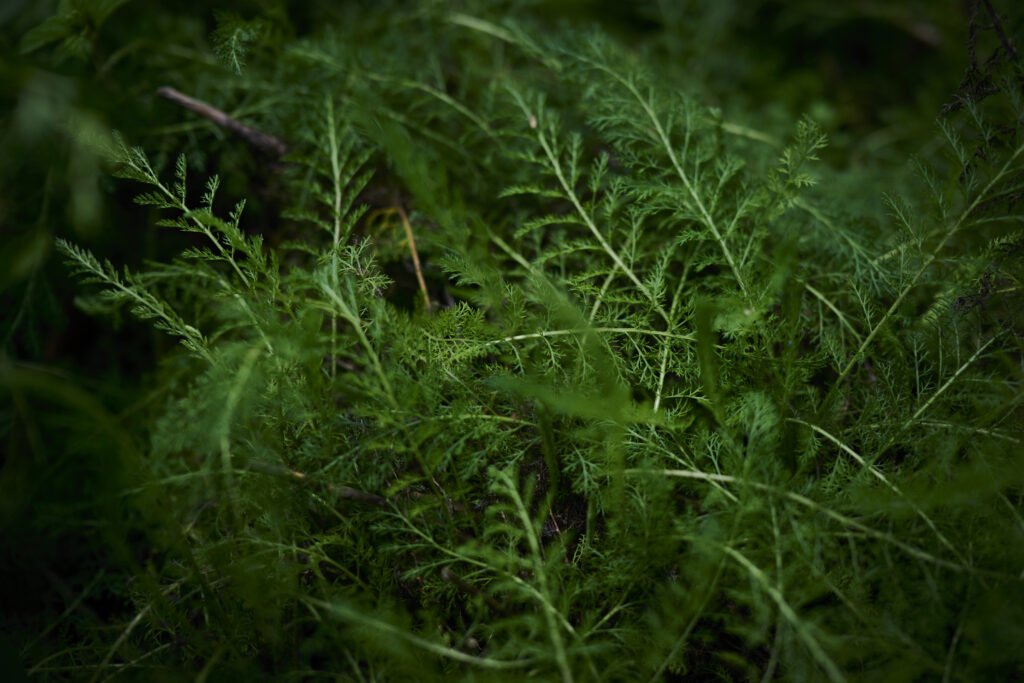
Highly regarded in many traditional medicinal practices, Achillea millefolium has been embraced since ancient times. Perhaps even as far back as 50,000 years ago when Neanderthals may have consumed yarrow as a form of self-medication.1 One of the earliest written accounts of A. millefolium in the European tradition is found in Dioscorides’ De Materia Medica, in which he notes that yarrow is “excellent for an excessive discharge of blood.”2
Indeed, the Greek’s knew this well. The genus name, Achillea, may derive from the Greek epic hero Achilles, who employed a bitter plant to heal his men’s wounds. In the Iliad we learn that Achilles was taught by the centaur Chiron to use:
IL.11.847 a bitter root to make pain disappear, one which stayed
IL.11.848 all kinds of pain. And the wound dried, and the flow of blood stopped.
IL.11.847 χερσὶ διατρίψας ὀδυνήφατον, ἥ οἱ ἁπάσας IL.11.848 ἔσχ’ ὀδύνας: τὸ μὲν ἕλκος ἐτέρσετο, παύσατο δ’ αἷμα.3
The association between the bitter root of Achillea millefolium and the legendary Greek warrior is more myth than fact, as no direct textual sources explicitly name the plant as such. The earliest written reference connecting A. millefolium with Achilles appears in Pliny the Elder’s Natural History (77–79 CE). Pliny recounts the tale involving a plant known as “achilleos” or “millefolium” reputed to heal wounds.4 Regardless, it is true that yarrow is analgesic and haemostatic. When fresh leaves tare chewed to release their juices and applied as a spit poultice to a cut, it can effectively staunch bleeding.
Nearly 900 years later, Bald’s Leechbook and Leechbook III include many yarrow based wound and burn salves, often combined with a fat like butter or lard. Hildegard von Bingen, a renowned medieval healer, also praises yarrow, noting that it “has distinguished and subtle powers for wounds” and prescribes yarrow for both internal and external injuries.5 In her book Plants Have So Much to Give Us, All We Have to Do Is Ask: Anishinaabe Botanical Teachings, Mary Siisip Geniusz shares that “the Waabanoo, those who practice the Waabanoowin religion, hold Waabanooganzh, yarrow, as their sacred medicine” and use it to protect their skin from burns during fire ceremonies.6 A veritable wound-healing wonder, yarrow is now known to possess valuable anti-inflammatory and antimicrobial properties, affirming its long-standing reputation in traditional medicine.7
As an antispasmodic, A. millefolium is traditionally believed to soothe digestive issues. A friend in Ukraine shared that, in her childhood, the attic of her home was full of yarrow as both her grandmother and mother dried yarrow for indigestion—not only for humans, but also for their birds and household pets. They would brew yarrow, let it cool, and then give it to the animals instead of water. For disease prevention, they would use a weaker solution, while a stronger brew was employed for treatment. Additionally, her grandmother would amend the chicken feed with the young green leaves.
This folk remedy finds a parallel in The Old English Herbarium, which prescribes yarrow brews- both fresh and dried, steeped in wine for intestinal pain and difficult digestion.8 However, in this case, the wine was meant for human consumption and not our furry or feathered friends. On the tongue, yarrow has a bitter and sometimes acrid taste, which can be off-putting to some. My friend adds a small amount of yarrow to her garden tea blends, allowing the other plants to harmonize and balance the flavor. Wine may have similarly served to make the brew more palatable.
Siisip Geniusz, in her teachings, suggests adding ginger to offset the yarrow’s bitterness, but humorously cautions “Under no circumstances mix Yarrow and Coca-Cola. The resulting nauseating mixture is memorable, but not something one would try a second time. I speak from experience.”9
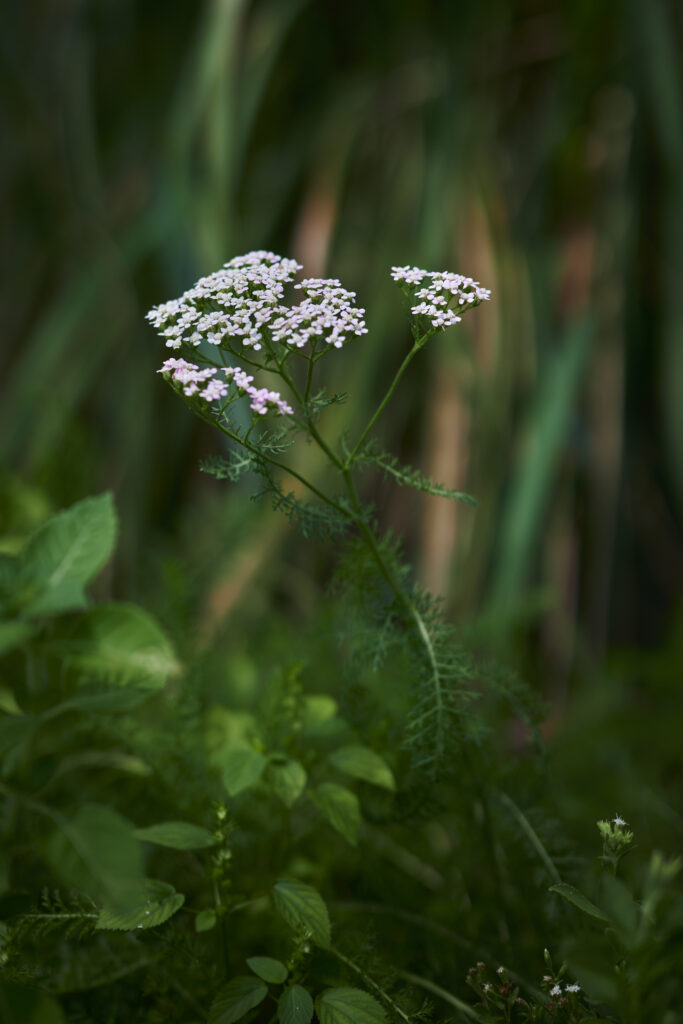
In the Medieval Welsh medical texts commonly known as Meddygon Myddfai (‘The Physicians of Myddfai’), similar recipes featuring yarrow are used to expel parasites, especially stomach worms. The general practice involved drinking yarrow in milk or room temperature wine, which was believed to cause the worms to emerge. Intriguingly, it is theorized that some wild birds also recognize the insecticidal properties of yarrow, lining their nests with fresh leaves to reduce parasites and protect their nestlings.10
It is important to note that the term “worm” (vermis) in medieval English had a broader meaning than it does today. It referred to a category that included a variety of unsavory invertebrates, like insects, nematodes, and arachnids. Sometimes worms were likened to demons of disease. In Bald’s Leechbook, there are several mentions of yarrow being used to rid the body of demonic influence. One particularly evocative prescription appears under the section heading “For demoniacs, when the devil feeds a man or controls him inside with sickness.” The treatment is as follows:
“corncockle, houndstongue, yarrow, lupin, marsh mallow, poison-bane, sedge, iris, fennel, church moss, moss from a cross, lovage, make the drink of clear ale, sing seven masses over the herbs, add garlic and holy water and drip into any drink that he intends to drink, and sing the psalms and then drink the drink from a church-bell, and the mass priest should sing this over the drink: Holy Lord, Father omnipotent.”11
If yarrow is a demon purging vermifuge, it isn’t surprising that the plant is also known to offer preventative protection from unwanted energies and beings. In the Carmina Gadelica, a text of collected folkloric beliefs and practices from Scotland, there is an apotropaic incantation for yarrow that is sweetly poetic, albeit with a plot twist:
I will pluck the yarrow fair,
That more benign shall be my face,
That more warm shall be my lips,
That more chaste shall be my speech,
Be my speech the beams of the sun,
Be my lips the sap of the strawberry.May I be an isle in the sea,
May I be a hill on the shore,
May I be a star in waning of the moon,
May I be a staff to the weak,
Wound can I every man,
Wound can no man me.12
In Ireland, yarrow also held a revered role in folklore, as recorded in The Schools’ Collection. One entry notes, “Yarrow was known as the herb of seven cures on account of its great healing power. A ‘charm for safety’ was made by plucking ten blades of yarrow; one of these was cast aside, and the remaining nine were placed in the stocking under the heel of the right foot. Thus, the traveler could go forth on his journey in safety, as the ‘Evil One’ had no power over him.”13
For the Anishinaabeg, as Mary Siisip Geniusz relates, yarrow also served as a protective herb. “In cases where a person is very worried about evil attacking them, for instance during a Bear Walk or in a haunting situation, dried yarrow is pounded and mixed with sand. The mixture is then poured across doorways and window sills or around the entire foundation of a home, or around the perimeter of a property. It is said that evil will not cross a line of yarrow.”14
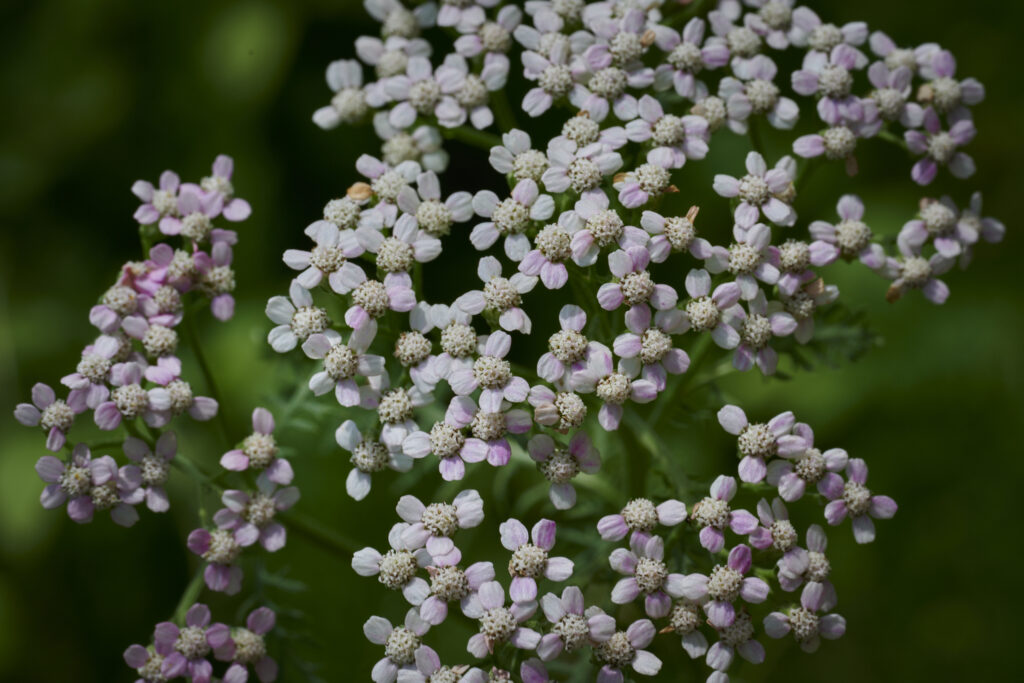
Despite its healing and apotropaic powers, Achillea millefolium has been demonized at certain points in history. In the trial of Dame Alice Kyteler, prosecuted for sorcery in Ireland in 1324 CE, Petronilla of Meath, an accomplice of Alice, confessed to making an offering of three roosters to a demon called Robert, son of Art. The testimony states, “She had poured out the cock’s blood, cut the animals into pieces and mixed the intestines with spiders and other black worms like scorpions, with a herb called milfoil [A. millefolium], as well as with other herbs and horrible worms.”15 Petronilla was subsequently burned as a heretic.
In Scotland in 1616, Elspeth Reoch met a similar fate. She was charged with gathering yarrow while reciting an incantation. It was said that she “plucked ‘ane herb called melefour’ . . . sitting on her right knee, and pulling it ‘betwixt the midfinger and thombe, and saying of In nomine Patris, Filii, et Spiritus Sancti.’ By the plant so gathered, she was enabled to cure distemper and to impart the faculty of prediction.”16
While these attitudes might seem like relics of the past, the fear of yarrow persisted into more recent times. Siisip Geniusz recalls that in the early 20th century, her teacher’s mother “used to soak her hands in a yarrow and alum infusion before she wove baskets . . . But someone told her that the use of plants, yarrow in particular, was an un-Christian practice. After that, she stopped using the yarrow infusion, and she would weave until her hands bled onto the black ash strips.”17
The fear of powerful plants endures, though cultural anxieties have shifted, and working with yarrow no longer puts one at risk. Perhaps it’s because yarrow tenaciously thrives under the glaring sun, but for me, working with yarrow is a comfort. When I’m spread thin and stressed out, I enjoy a cup of yarrow tea. Among all of yarrow’s other beneficial properties, A. millefolium acts as a nervine, helping to ease tension and calm the nervous system. There’s something about the bitterness of yarrow, smoothed over with a spoonful of honey, that drops the shoulders, brings you into the body, and puts things into perspective.
If you are looking to cultivate resiliency, I encourage you to go out and introduce yourself to yarrow. Taste a leaf, inhale her perfume—I promise, you’ll never forget her.
Margaux Crump is a gardener and interdisciplinary artist exploring the entanglements between ecology, spirituality, and power. She is currently investigating the phenomena of unseen worlds, from the microscopic to the parallel mythic realms that surround us. Follow her on Instagram @margauxcrump
References
1. Karen Hardy, Stephen Buckley, and Michael Huffman. “Neanderthal Self-Medication in Context.” Antiquity 87, no. 337 (2013): 873–78. https://doi.org/10.1017/S0003598X00049528.
2. Dioscorides Pedanius, De Materia Medica: Being an Herbal with Many Other Medicinal Materials, trans. Tess Anne Osbaldeston, Robert P. A. Wood, (South Africa: Ibidis, 2000), 652.
3. Homer, Iliad, 11.847-848. trans. Richmond Lattimore, Iliad of Homer, (University of Chicago Press: 1951, 2011) 276.
4. Pliny the Elder, The Natural History of Pliny, trans. John Bostock and H.T. Riley, (London: Taylor and Francis, 1855) 25.19. The Natural History of the Wild Plant,
http://data.perseus.org/citations/urn:cts:latinLit:phi0978.phi001.perseus-eng1:25.
5. Hildegard von Bingen, Hildegard Von Bingen’s Physica: The Complete English Translation of Her Classic Work on Health and Healing, trans. Priscilla Throop, (Rochester: Healing Arts Press, 1998), 59-60.
6. Mary Siisip Geniusz, Plants Have So Much to Give Us, All We Have to Do Is Ask: Anishinaabe Botanical Teachings, (University of Minnesota Press, 2015) 177–184.
7. Wendy Applequist and Daniel Moerman, “Yarrow (Achillea millefolium L.): A Neglected Panacea? A Review of Ethnobotany, Bioactivity, and Biomedical Research,” Economic Botany 65, no. 2 (2011): 209-225. https://doi.org/10.1007/s12231-011-9154-3
8. Anne Van Arsdall, Medieval Herbal Remedies: The Old English Herbarium and Anglo-Saxon Medicine (United Kingdom: Routledge, 2002), 187–88.
9. Siisip Geniusz, Plants Have So Much to Give Us, 177-184.
10. Dave Shutler and Adam A. Campbell, “Experimental addition of greenery reduces flea loads in nests of a non-greenery using species, the tree swallow Tachycineta bicolor,” Journal of Avian Biology 38, no. 1 (2007): 7-12. https://doi.org/10.1111/j.2007.0908-8857.04015.x
11. Conan Turlough Doyle, Anglo-Saxon Medicine and Disease: A Semantic Approach, Apollo – University of Cambridge Repository. (2017): 141. https://doi.org/10.17863/CAM.14430.
12. Alexander Carmichael, Carmina Gadelica: Hymns and Incantations Vol 2, (Edinburgh: Oliver & Boyd, 1928), 95.
13. National Folklore Collection, Volume 0883, 108–109; Mrs O’ Brien (75), Coolcull (Moylers), Co. Wexford. Collector: Kathleen Curran, 1938
14. Siisip Geniusz, Plants Have So Much to Give Us, 177-184.
15. The Sorcery Trial of Alice Kyteler, ed. L.S. Davidson and J.O. Ward, (Binghamton: Center for Medieval & Renaissance Texts & Studies, 1993): 62–63.
16. James Britten, “Plant-Lore Notes to Mrs. Latham’s West Sussex Superstitions,” The Folk-Lore Record 1 (1878): 155–59.
17. Siisip Geniusz, Plants Have So Much to Give Us, 177-184.
Plantings
Issue 39 – September 2024
Also in this issue:

The Art of the Brew: Exploring Hops and Other Plant Ingredients That Define Beer
By Gayil Nalls
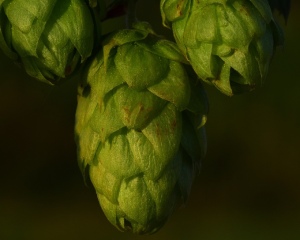
Beyond the Brew: The Medicinal Power of Hops
By Ian Sleat

Beer Domesticated Man
By Gloria Dawson

Plants, Psychodiversity, and the Paranormal
By Jake Eshelman

Inside the Floral Mind: A Conversation with Kreetta Järvenpää
By Gayil Nalls
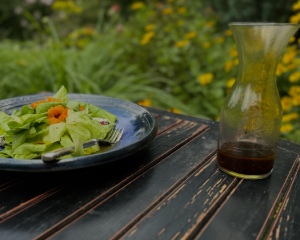
Eat More Plants Recipes:
Raspberry Balsamic Dressing
By Diane Reiss

As Ireland transitions from the rich, smoky scent of peat-burning to a more sustainable future, its olfactory heritage is evolving. What will become the next iconic aromatic symbol of Ireland?
Click to watch the documentary trailer.

